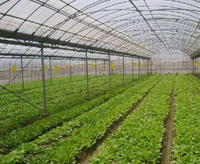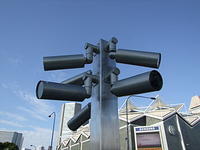-
Unexpected pleasures: a new airport security-check experience
If airport security checks cannot be made to move at a quicker pace, how about making them more comfortable, even pleasant? This is what a pilot project at the Dallas/Fort Worth (DFW) International Airport’s Terminal E is trying to do. SpringHill Suites by Marriott has brought its hotel experience to E18 security check point, where passengers will now be welcomed by a stylish decor, soothing wall art, vibrant lighting, and relaxing ambient music in a setting that spans the entire checkpoint area. Lounge seating at the entrance and a furnished area for customers to gather their belongings after the screening process.
-
-
Irish heritage groups sues U.K. over nuclear power plant
An Taisce, an Irish charity group promoting the preservation of Ireland’s heritage, is taking the British government to the High Court in London in December seeking a judicial review of the legality of British energy minister Ed Davey’s decision to approve the construction of a nuclear power plant just 150 miles from the Irish coast without consulting the Irish public.
-
-
Small changes in agricultural practices reduce produce-borne illness

Foodborne illness sickens an estimated 9.4 million and kills around 1,300 annually in the United States, according to the Centers for Disease Control and Prevention. Produce accounts for nearly half the illnesses, and 23 percent of the deaths. Researchers have identified some agricultural management practices in the field that can either boost or reduce the risk of contamination in produce from two major foodborne pathogens: salmonella, the biggest single killer among the foodborne microbes, and Listeria monocytogenes.
-
-
Police departments adopt sophisticated, cheap-to-operate surveillance technology

Advancements in surveillance technology have been adopted not only by the National Security Agency (N.S.A) or other federal intelligence agencies. Local police departments have also incorporated the latest surveillance technologies into their work, allowing them to track individuals for different purposes.
-
-
Better protective shield material for nuclear waste
The integrity and survivability of a nuclear waste package is critically important in the transport of nuclear fuel and high-level waste. Research are working on developing an outer shield material for use in packaging which is resistant to corrosion, radiation, diffusion, and thermal cycling processes that affect fuel packages during long-term storage. The material will also need to be wear-tolerant and mechanically robust so that it can survive repeated handling and transportation.
-
-
Number of university-hosted start-up incubators grows
U.S. colleges and universities increasingly resemble business incubators, as the number of school-supported startups is rising.Of the 1,195 incubator programs in North America in 2012, about 400 – or a third — were primarily sponsored by a college or university, an increase from just 20 percent in 2006.In 2012, U.S. higher education institutions earned $2.6 billion in license income, and helped launch 705 startups.
-
-
S&P: U.S. government shutdown shaved 0.6 percent off Q4 annualized GDP
Standard & Poor’s said the U.S. government shutdown trimmed 0.6 percent off fourth quarter growth, taking $24 billion out of the economy. S&P notes that in September, the rating agency expected 3 percent annualized growth of the U.S. economy in the fourth quarter, but that that expectation was based on the assumption that “politicians would have learned from 2011 and taken steps to avoid things like a government shutdown and the possibility of a sovereign default. Since our forecast didn’t hold, we now have to lower our fourth-quarter growth estimate to closer to 2 percent.” S&P warns that “If people are afraid that the government policy brinkmanship will resurface again, and with it the risk of another shutdown or worse, they’ll remain afraid to open up their checkbooks. That points to another Humbug holiday season.”
-
-
U.S. formulates strategy for a new Arctic landscape
U.S. national security officials have become increasingly concerned about the national security implications of an ice-free Arctic. The Arctic will become ice-free during the summer by mid-decade. In a strategy document, the Pentagon says: “Melting sea ice in the Arctic may lead to new opportunities for shipping, tourism, and resource exploration, but the increase in human activity may require a significant increase in operational capabilities in the region in order to safeguard lawful trade and travel and to prevent exploitation of new routes for smuggling and trafficking.”
-
-
U.S. nuclear power industry facing growing challenges
The U.S. nuclear industry is scaling back expectations on the future of the industry, expectations which only a few were soaring. The availability of cheaper energy alternatives, a growing trend toward energy conservation, and renewed safety and health worries as a result of the 2011 Fukushima Daiichi Nuclear Power Plantaccident, are all reasons for why active nuclear plants are being forced to close, and why fewer energy companies are investing in new nuclear plants or upgrading existing ones.
-
-
The Red Cross wants video games to incorporate the Geneva Convention
Approximately 600 million video-gamers worldwide may be violating the laws of war – at least virtually. For the past two years, a unit of the ICRC has been working on discouraging video game creators from allowing players to disregard the rules of war – that is, disregard the rules of war while playing a video game, not in real life — without consequences. ICRC calls for gamers to be “rewarded for respecting the law of armed conflict and there should be virtual penalties for serious violations of the law of armed conflict, in other words war crimes.”
-
-
Shutdown shuts down E-Verify
The law requires that businesses verify the work eligibility of new hires within three days of hiring. Staffing companies which place employees with companies do the verification before placing employees. E-Verify has been turned off as a result of the government shutdown, causing headaches for businesses, boosting their administrative costs, and possibly landing them in legal trouble.
-
-
Renewable fuel standard: mend it, don’t end it
Congress should minimally modify — and not, as petroleum-related interests have increasingly lobbied for, repeal — the Renewable Fuel Standard (RFS), the most comprehensive renewable energy policy in the United States, according to a new paper. The paper argues that RFS mandates merely ought to be adjusted to reflect current and predicted biofuel commercialization realities.
-
-
Halt of CFATS work disrupts debate over program’s merit
The budget impasse-related halting of monitoring and enforcing compliance with the 2007 Chemical Facility Anti-Terrorism Standards (CFATS) comes at a time of growing criticism of the measure by GOP – but not only GOP – lawmakers, who complain that there are too many problems with CFATS and the way it has so far been implemented.
-
-
Russia to improve image by developing patriotic video games
The Russian government has complained that the videogame is “Company of Heroes,” which is popular among Russian teenagers, distorts history by depicting a Second World War Russian soldier as a criminal and arsonist. The government is considering banning the game – and has also launched its own videogame project to produce games which contribute to “patriotic education.” In the meantime, a Belgian videogame developer is set to release a mobile game, titled “You Don’t Mess with Putin,” which depicts Russian president Vladimir Putin and a fictional sidekick, an alcoholic American named Mike, battling zombies who attack a Putin news conference.
-
-
ASCB: U.S. scientific research will "pay dearly" for shutdown
The American Society for Cell Biology (ASCB) added its voice to those of other scientific and professional groups in warning that the federal government’s partial shutdown will hurt patients, researchers, and especially the U.S. research effort, long after an agreement to end the impasse is reached. “As America keeps hitting the brakes on scientific research, we are, in effect, accelerating the damage done to our continued leadership in global bioscience, in health outcomes and in the economic power that we have always derived from basic research,” Dr. Bertuzzi, executive director of the ASCB said. “Americans will pay dearly for these slowdowns, sequestrations, and shutdowns in finding cures and on maintaining economic competitiveness.”
-
More headlines
The long view
Factories First: Winning the Drone War Before It Starts
Wars are won by factories before they are won on the battlefield,Martin C. Feldmann writes, noting that the United States lacks the manufacturing depth for the coming drone age. Rectifying this situation “will take far more than procurement tweaks,” Feldmann writes. “It demands a national-level, wartime-scale industrial mobilization.”
Trump Is Fast-Tracking New Coal Mines — Even When They Don’t Make Economic Sense
In Appalachian Tennessee, mines shut down and couldn’t pay their debts. Now a new one is opening under the guise of an “energy emergency.”
Smaller Nuclear Reactors Spark Renewed Interest in a Once-Shunned Energy Source
In the past two years, half the states have taken action to promote nuclear power, from creating nuclear task forces to integrating nuclear into long-term energy plans.
